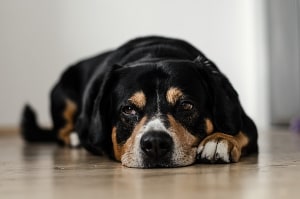
If you’ve ever watched your dog sleep, you might have seen them twitching when they’re dreaming.
Maybe they’re chasing their favorite squirrel through your yard, or they might even be dreaming about you!
But what happens when your dog twitches when they are still awake? And what causes it?
Read on to find out why your dog might be twitching and what it might mean.
Why do dogs twitch when they are awake?
There are a few reasons dogs might twitch when they are awake.
One reason is from hiccups. Just like humans, dogs can develop hiccups when they eat or drink too quickly.
According to the American Kennel Club, dogs get hiccups from a spasm in their diaphragm, the muscle under the lungs, which causes the opening in the vocal chords (called the glottis) to contract suddenly.
The spasm makes a “hic” sound, thus called a hiccup.
While hiccups aren’t dangerous, they can be annoying. You can try to alleviate them by rubbing your dog’s belly or trying to get him to eat a small meal.
Your dog might also be twitching while he’s awake if he has tick paralysis.
If you live in a rural area, your dog might like to play outside where ticks can easily pop out and latch onto your dog’s skin.
Certain female ticks carry a disease, which when bitten, can transfer to your dog.
The disease carries harmful toxins that can cause paralysis in dogs, which usually starts with twitching when your dog is awake.
If you find a tick on your dog and your furry friend is twitching, be sure to get him to a vet immediately.
Another important cause of twitching is seizures.
Seizure twitching is very different from normal twitching, like when your dog is dreaming, and it can be scary to witness.
If your dog is twitching because of a seizure, his limbs will usually be stiff and the movements can be wild and unnatural.
Dogs having a seizure might vomit, defecate, or pee themselves due to loss of control of their body.
It is impossible to wake your dog up from a seizure, but if you see him twitching with unusual behaviors, be sure to try to record his actions and time the length of the seizure—this information can be crucial when communicating with your dog’s vet to determine the cause and treatment.
If you’re worried your dog might have seizures, keep reading to learn about epilepsy in dogs.
[1a] Why do parts of a dog’s body spasm? (answered in question 1)
Apart from twitching, what are the main symptoms of epilepsy in dogs?
There are many symptoms a dog with epilepsy might experience, especially before or after a seizure. Some signs to look out for are:
- Collapse or falling down to one side
- Excessive drooling or foaming at the mouth
- Frenzied barking, whining, or moaning
- Head shaking
- Incontinence
- Mental or behavioral changes
- Signs of panic or bewilderment
- Signs of confusion
- Staring into space
- Temporary loss of eyesight
- Vomiting
- Weakness
These are only a few signs your dog has epilepsy, and your dog might have different symptoms. Every time your dog has a seizure, be sure to write down what happens—this can be very helpful for your dog’s veterinary team. If you suspect your dog might have epilepsy and you haven’t talked to your vet yet, be sure to call them right away. Seizures can be life threatening if they are not managed properly.
If you think your dog has epilepsy, you might also be wondering what causes it. Read on to learn some of the main causes of epilepsy in dogs.
What are the main causes of epilepsy in dogs?
Epilepsy is a brain disorder that causes dogs to have seizures. But what causes the disease?
Epilepsy typically occurs for one of two reasons. Most epileptic dogs have an inherited genetic component, meaning that they have a gene from their parents, or their breed, that predisposes them to have seizures. Usually, large breed dogs are more likely to have genetic predispositions to the disease. Epilepsy might also be idiopathic, which means that vets aren’t sure what the cause is where the disease comes from. Idiopathic epilepsy usually forms structural lesions in the brain that can be diagnosed from a brain scan. While we don’t know why, idiopathic epilepsy is usually more common in male dogs.
The good news? Although epileptic attacks can be scary, most dogs with epilepsy can live happy, healthy lives on medication. Although the disease isn’t curable, epilepsy can usually be managed by diligent pet owners.
Keep reading to learn more about why your dog might be twitching when they’re awake.
Why do dogs get hiccups?
Hiccups can happen for any number of reasons. Dogs that are young are usually more pre-disposed to getting hiccups. Hiccups can also occur if your dog likes to eat or drink quickly. If you find your dog tends to get hiccups after eating quickly, you can try getting him a slow feeder bowl to teach him to slow down when eating his meals. You also try feeding smaller meals several times a day.
Is this twitching behaviour more likely to be seen in older dogs?
Twitching from hiccups is much more common in puppies than older dogs—this is because puppies get excited easily and they are more prone to rapid bursts of energy, which can affect their breathing. Younger dogs are almost more likely to eat quicker, which can cause hiccups.
If you have an older dog and you see twitching behavior that doesn’t follow a rapid burst of energy or scarfing down his food, it might be cause for concern and time to call in a vet.
How can I stop hiccups (once they have started)?
Once hiccups start, it can be hard to get them to stop. While humans might hold their nose, try a spoonful of sugar, or stand upside down, I hardly think you’ll be able to convince your dog to try some of these silly methods. Instead, try rubbing his belly gently, or convincing him to eat or drink something small, slowly. If these approaches don’t work, there’s no need to worry. Most bouts of hiccups don’t last long and they usually go away on their own in just a few minutes.
How can I calm my dog during an epileptic fit?
While there’s no way to stop an epileptic fit, you can try to keep your dog calm to help them through a seizure. Seizures can be scary for everyone, especially your dog, who is likely confused about what’s happening. The most important thing is to remain calm and talk softly to your dog. Let him know that it’s okay, and it will be over in a few minutes. Try to remove any nearby options that can hurt your dog if he begins thrashing around, like tables with sharp edges, or hard dog toys. Be sure not to yell at your dog or use any tone of voice that might scare him further. After all, it’s not his fault, and it can be very confusing as your dog goes through an epileptic fit.
One thing to note is that dogs can become disoriented during and after a seizure. It’s not uncommon for your dog to be scared of you or not recognize you—some dogs can even become aggressive. If you’re not sure how your dog might act, proceed with caution when touching him or getting too close.
How is epilepsy managed in dogs?
While there’s no way to prevent epilepsy, there are several treatments that exist to help manage seizures in dogs with the disease. Symptoms can usually be managed by vet-prescribed medications and a special diet. Supplements like MCT oil (medium chain triglycerides) have also been found to be helpful in managing epileptic episodes. If your dog is having seizures, never try to manage episodes on your own—epilepsy should always be treated by a qualified veterinarian.
How are body twitches and hiccups different?
Twitching from epilepsy is very different from hiccups. If your dog is making a “hic” noise and his whole body twitches at once, every few seconds, he likely is dealing with hiccups. If your dog has hiccups, he will still be conscious and his limbs will function naturally. Unlike hiccups, a seizure will cause your dog’s body to twitch unnaturally, and his limbs will usually be very stiff. Your dog might also make unusual barking or whining noises—symptoms are usually uncontrollable and your dog will probably be confused or scared.
Closing Thoughts
If your dog is twitching, it might worry you enough to raise the alarm—but, there’s not always cause to panic. Dogs can often twitch during episodes of hiccups, short outbreaks that cause your dog to make a “hic” sound while his body twitches. Hiccups are harmless and are usually caused by too much excitement.
However, if you notice your dog twitching unnaturally or presenting strange symptoms, you might need to be concerned about epilepsy. If you’re concerned about your dog’s wellbeing and you’re not sure why he’s twitching while he’s awake, always consult your veterinarian for a professional opinion on your dog’s health.






